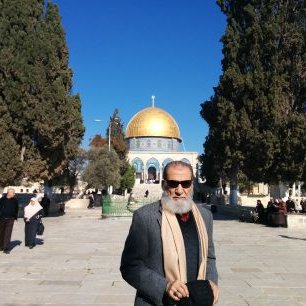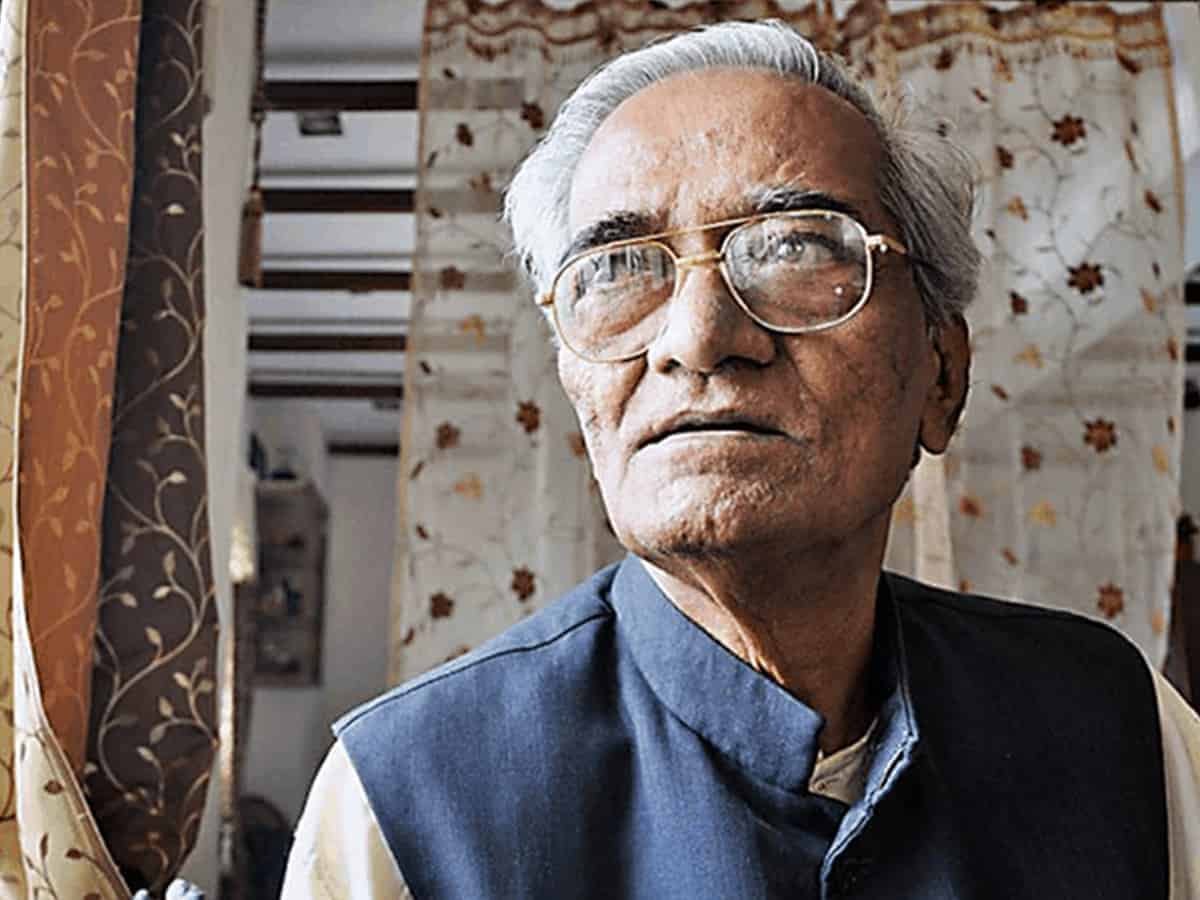
Hyderabad: UNDOUBTEDLY Mujtaba Hussain and Anand Mohan Zutshi, Aka, Gulzar Dehlvi who departed from this vale of tears one after the other in short the span of time were last of the Mohicans of a genre of men of letters who left deep impressions of their literary brilliance on the fading canvas of Urdu, a language that unfortunately has to bear the brunt of the prevailing religious and political arraignments sweeping across the country.
Mujtaba Hussain
Mujtaba Hussain a Hyderabadi to the core was an outstanding satirist who commanded a vast readership and envious popularity among the Urdu speaking diaspora across the globe. Gulzar Anand, cutting short his full name for brevity was an epitome of Urdu a language, a culture and a class that regretfully has disappeared losing out to the neo-Urdu literary, cultural, and intellectual trends, noticeable at Mushairas in unbecoming sartorial preferences (Three-piece suits). A Kashmiri Pandit, the last inline of the great poets that Kashmir produced from the legendry Habba Khatoon, Mehzoor(Peerzada Ghulam Ahmed) and lal Dadh (poetess). Attired immaculately, he would never be seen in Mehfils and Mushairas sans his trademark spotless cream shaded Sherwani and a slim Kashti Numa (boat-shaped cap) of the same hue, with a red button rose tucked in one of the upper buttonholes of his sherwani.
The former an octogenarian and the later a nonagenarian precociously alert for their ages were the ventilators for Urdu maintaining the rhyme and the refrain of the language as it inches towards its final throes of losing its literary nuances to a rising new breed of poetasters, ballad mongers and penny liners, who, not to deny their due, keep Urdu limping progressively forward with their progressive writings, lacking the magical cusp and flavor that made the language darling of the highbrow and the commoner.
Languages flourish with power and culture
Hindustan was bastion of the Persian language spoken with a flourish by all and sundry though with varying literary ease till the much easier to speak and write Urdu came to replace it in 1834. As the Mughal kings and princesses were fading into oblivion powerless and stripped of their legendry wealth and grandeur, it was the hapless doddering old last of the great Mughals, Emperor Bahadur Shah Zafar, a Sahib Dewan poet(portfolio), who kept the flame of Urdu flickering conducting Mushairas at the decrypting Red Fort. So mesmerizing and enchanting is one of his famous couplets lamenting his agonizing exile to Burma by the Colonial British ‘ KITNA HAI BADH NASEEB ZAFAR DAFN KE LIYE DO GAZ ZAMEEN NA MILI KU E YAR MEIN” is still echoed albeit melancholically at Mushairas and Ghazal evenings across the globe. One of the illustrious exponents of Urdu prose, Farhat Ullah Beg Dehlvi has beautifully contoured the charm, elegance and the refined ambiance of the Mushairas that were held in Bahadur Shah Zafar’s’ Delhi, in his imaginative narrative titled “ Delhi ka ek yaad gaar Mushariah”
As the Mughal empire dismembered Urdu fortunately found a committed royalty and a dedicated literati among in the Royals of Awadh, Lucknow, Rampur, and Hyderabad, that provided royal patronage essential for any language to flourish. The erstwhile rulers of these princely states had a penchant for patronizing art and culture. Mir Mehboob Ali Khan the VI Nizam of Hyderabad and his illustrious son Mir Osman Ali Khan, the V11 and the last Nizam were Sahib Diwan( portfolio) poets and known patronizers of poets and academicians. Incidentally of the two sons of Osman Ali Khan, the younger, Prince Moazzam Jah Bahadur lived fully the traits of his father and grandfather writing verses under the pen name of Shajee. Even Osman Ali Khans prime minister Sir Kishen Prashad was an accomplished scholar of Urdu. The Nizams’ court provided patronage to some of leading Urdu poets and academicians of their time from across India. Jaleel Manikpuri, Dagh Dehlvi, Josh Maleehabadi, Fani Badaunee,Ameer Meenai and Sidqh Jaisi and many local poets were hosted by them for years on. Nawab Hamid Ali Khan of Rampur, father of Nawab Reza Ali Khan was also a Sahib Diwan poet and so were few royals of Awadh and Lucknow.
It was arguably the belle époque era of Urdu in all of its forms from the popular ghazal to elegies and prose. The great souls that made Urdu the crowning glory of the composite culture that prevailed in post-independence India were not all Muslims. There was a battery of writers and poets who were Hindus excelling in Urdu prose and poetry. The Shuora’a (poets) of the time were fully alive to the need of the time and responded accordingly showing muscle condemning tyranny and oppression. In addition to the traditional paeans for the beloved, extolling doe eyes, cascading tresses, bleeding hearts and floating Anchals( headscarf) arching Abroo( eyebrows), they penned fiery verses igniting the urge to fight the British out of India. In recent times Faiz Ahmed Faiz, Habeeb Jalib, and Ahmed Faraz are few of the poets who suffered incarceration for their stand against dictators.
Raja Ram Narain Mouzon is said to be the first Urdu poet to raise his voice against the British, Chandra Bhan Brahmin, Pandit Ratan Nath Sarshar authored Fasane e Azad, Pandit Brij Narayan Chak Bast. Dayal Shanker Naseem translated ‘Arabian Nights’ to Urdu. These were men who penned heart touching and passionate poetry calling for Azadi. ‘Inqhilab Zinda Baad ‘( Long live revolution) was sloganeered by Hasarth Mohani, a poet and freedom fighter. Ram Prasad Bismils’ Sarfrooshi ki Tammna Ab Hamre Dil Mein hai,’ the couplet that Shaheed Bhagat Singh had on his lips while walking to the gallows. Subash Chandra Bose’s Indian National Army motto was in Urdu. Ittihad( Union) Etimad (trust) Qurbani( sacrifice), Sir Sayyid Ahmed Khan, Altaf Hussain Hali, Mohammed Hussian Azaad, Ali Brothers, Manto, Maulana Azaad, Zafar Ali Khan stand tall in the hall of fame of Urdu and its contribution to the fight for freedom.
Urdu’s journey to the present time has been full of ups and downs of moments of disappointment, disillusionment, and helplessness and of at the same time, the bright moment of promises, progress, and success. The 1857 war of Independence sounded the death knell for Urdu. It found a competitor in Hindi proxied by a group of North Indian Hindus and the British mauled in the war for independence. And perhaps, an element of latent revenge that generated a campaign against Urdu in 1867, supporting Hindi and within 30 years in 1897, Hindi was upgraded to government level.
The post-independent era had its own battery of brilliant Urdu exponents who stretched the purity and nuances of the language alive to date, Faiz Ahmed, Faiz, Habeeb Jalib, Faraz, Shaaz Tamkanat, Gopi Chand Narang, Majaaz, Sahid Siddiqui, Firaq Gorukpuri, Khumaar Bara Bankvi, Maqhdoom , Mohiuddin, Kaifi Azmi, Majrooh Sultan Puri, Sahir Ludhyanvi, Ali Sardar Jafri, Jann Nisar Akhtar, Javed Akhtar, Rajender Singh Bedi, Baikal Utsahi, Munawar Rana, Jigar Moradabad, Waseem Barelvi, Krishn Bihari Noor, Rahat Indoori. And many more.




